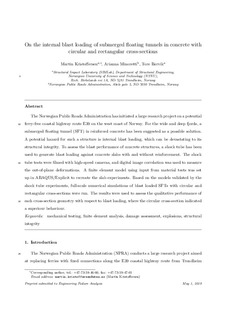| dc.contributor.author | Minoretti, Arianna | |
| dc.contributor.author | Børvik, Tore | |
| dc.date.accessioned | 2019-05-29T06:04:28Z | |
| dc.date.available | 2019-05-29T06:04:28Z | |
| dc.date.created | 2019-05-28T10:16:27Z | |
| dc.date.issued | 2019 | |
| dc.identifier.citation | Engineering Failure Analysis. 2019, 103 462-480. | nb_NO |
| dc.identifier.issn | 1350-6307 | |
| dc.identifier.uri | http://hdl.handle.net/11250/2599329 | |
| dc.description.abstract | The Norwegian Public Roads Administration has initiated a large research project on a potential ferry-free coastal highway route E39 on the west coast of Norway. For the wide and deep fjords, a submerged floating tunnel (SFT) in reinforced concrete has been suggested as a possible solution. A potential hazard for such a structure is internal blast loading, which can be devastating to its structural integrity. To assess the blast performance of concrete structures, a shock tube has been used to generate blast loading against concrete slabs with and without reinforcement. The shock tube tests were filmed with high-speed cameras, and digital image correlation was used to measure the out-of-plane deformations. A finite element model using input from material tests was set up in ABAQUS/Explicit to recreate the slab experiments. Based on the models validated by the shock tube experiments, full-scale numerical simulations of blast loaded SFTs with circular and rectangular cross-sections were run. The results were used to assess the qualitative performance of each cross-section geometry with respect to blast loading, where the circular cross-section indicated a superiour behaviour. | nb_NO |
| dc.language.iso | eng | nb_NO |
| dc.publisher | Elsevier | nb_NO |
| dc.rights | Attribution-NonCommercial-NoDerivatives 4.0 Internasjonal | * |
| dc.rights.uri | http://creativecommons.org/licenses/by-nc-nd/4.0/deed.no | * |
| dc.title | On the internal blast loading of submerged floating tunnels in concrete with circular and rectangular cross-sections | nb_NO |
| dc.type | Journal article | nb_NO |
| dc.type | Peer reviewed | nb_NO |
| dc.description.version | acceptedVersion | nb_NO |
| dc.source.pagenumber | 462-480 | nb_NO |
| dc.source.volume | 103 | nb_NO |
| dc.source.journal | Engineering Failure Analysis | nb_NO |
| dc.identifier.doi | 10.1016/j.engfailanal.2019.04.074 | |
| dc.identifier.cristin | 1700757 | |
| dc.description.localcode | © 2019. This is the authors’ accepted and refereed manuscript to the article. Locked until 7 May 2021 due to copyright restrictions. This manuscript version is made available under the CC-BY-NC-ND 4.0 license http://creativecommons.org/licenses/by-nc-nd/4.0/ | nb_NO |
| cristin.unitcode | 194,64,45,0 | |
| cristin.unitname | Institutt for konstruksjonsteknikk | |
| cristin.ispublished | true | |
| cristin.fulltext | postprint | |
| cristin.qualitycode | 1 | |

